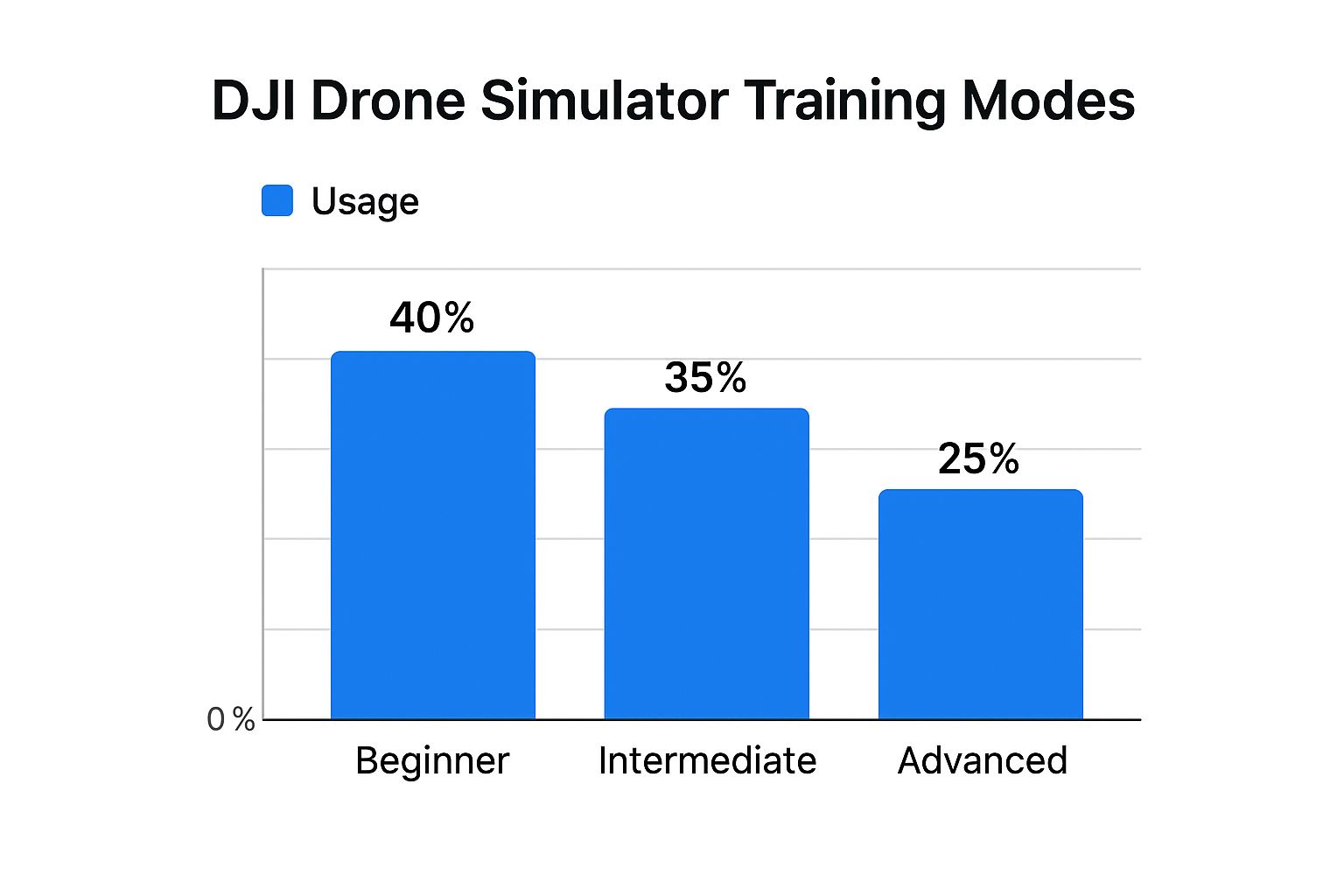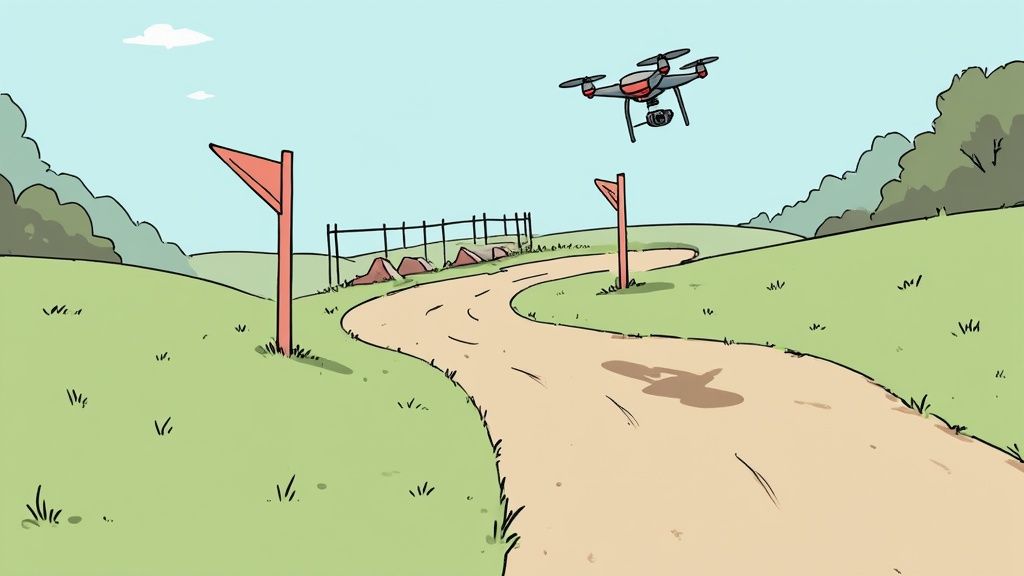DJI Drone Simulator: Master Flight Skills Fast
- James Baptiste
- Jun 6
- 12 min read
Understanding Why DJI Simulator Training Works

DJI drone simulators are invaluable tools for pilots of all skill levels. They go beyond simple games, providing a realistic flight experience thanks to sophisticated physics engines. These engines accurately replicate real-world flight dynamics, modeling factors like wind resistance, gravity, and inertia. This realistic approach creates a safe environment to hone skills without the risks of actual flight.
The Science Behind Simulator Effectiveness
Practicing on a DJI drone simulator translates directly to improved real-world flight performance. Just like flight simulators used by airline pilots, these programs build crucial muscle memory and enhance reaction times. The inclusion of diverse weather simulations, ranging from clear skies to challenging wind and rain, prepares pilots for various conditions. This virtual exposure builds confidence and competence in handling adverse situations. For more insights into mastering DJI flight simulators, check out this helpful resource: How to master DJI flight simulators.
Building Proficiency Through Virtual Practice
DJI simulators provide a variety of aircraft models and specialized training modules. This allows pilots to explore different DJI drone platforms and learn their unique characteristics. The simulator offers targeted training for diverse needs, whether it's perfecting precise aerial photography maneuvers or navigating complex environments for inspections. This focused practice significantly accelerates learning and skill development.
Market Growth and Industry Impact
The growing complexity of drone operations and the increasing integration of AI are fueling the demand for advanced simulation systems. The DJI Drone Simulator, along with other drone simulators, provides a risk-free platform for practice and skill refinement. The global drone simulator market, valued at USD 799 million in 2022, is projected to reach USD 1,501 million by 2027, exhibiting a CAGR of 13.4%. This growth reflects the increasing importance of simulators in supporting evolving drone capabilities and AI integration. You can learn more about this growing market here. This emphasizes the vital role simulator training plays in the expanding drone industry.
Getting Your DJI Simulator Setup Right
Setting up your DJI drone simulator correctly is essential for a productive and engaging learning experience. A well-configured simulator becomes a valuable training aid, helping you transition smoothly from virtual practice to real-world flights. This guide walks you through the key steps to optimize your DJI simulator experience.
Hardware Considerations: Building Your Simulator Cockpit
First, let's look at your controller. For the most realistic experience, use the same DJI controller you use with your drone. This consistency between simulator and real-world equipment builds muscle memory and improves flight control.
Next, consider your computer's specifications. While you don't need a top-of-the-line gaming PC, ensure your system meets the minimum requirements for the simulator software. A decent graphics card and processor are important for smooth performance.
Finally, think about a VR headset. Though not necessary for beginners, a VR headset adds another level of immersion, enhancing the sense of presence in the simulated environment. This is especially helpful for practicing First Person View (FPV) flying.
Software Setup and Optimization: Fine-Tuning Your Virtual World
After assembling your hardware, setting up the DJI simulator software is the next critical step. This includes installing the correct software for your DJI drone model and configuring it for optimal performance.
Start by creating a DJI account, or logging in if you already have one. This connects your simulator activity to your DJI profile.
Then, calibrate your controller within the simulator. Accurate input is essential for effective training. This mirroring of the real-world drone setup makes the simulator a more valuable learning tool.
Next, adjust your graphics settings according to your computer's capabilities. Balance visual quality with smooth frame rates. A choppy simulation can make learning difficult.
Finally, explore the training modules within the DJI simulator. These modules offer structured lessons, from basic flight maneuvers to more advanced techniques like aerial cinematography.
Troubleshooting and Common Setup Issues: Overcoming Initial Hurdles
Even with careful preparation, you might encounter some setup challenges. A common issue is controller connectivity. Ensure your controller is correctly paired with your computer via USB or Bluetooth. JAB Drone offers helpful resources for DJI controllers.
If using a VR headset, check its compatibility with the simulator software and adjust its settings for the best performance.
Another frequent problem is lag or choppy visuals. Lowering the graphics settings within the simulator often resolves this.
If you continue to have problems, online forums and DJI support can help you find specific solutions.
By carefully setting up your DJI drone simulator, you're building a valuable training platform. This thoughtful approach to simulator training will lead to better real-world flight skills and a safer, more enjoyable drone experience overall.
Mastering Essential Flight Modes and Training Features
Your DJI drone simulator offers more than just basic flight practice. It's a powerful tool for developing real-world skills, from precise hovering to complex cinematography. Let's explore how to unlock its full potential.
Understanding DJI Drone Simulator Flight Modes
Different flight modes within the DJI drone simulator target specific abilities. Beginner mode offers a simplified experience, perfect for learning the basics of takeoff, landing, and simple maneuvers.
Intermediate mode introduces more realistic physics and control, preparing pilots for common flight scenarios.
Finally, Advanced mode exposes you to challenging conditions like wind and obstacles, mirroring complex real-world operations.
You might be interested in: How to master your skills with a DJI drone simulator.
Targeted Training Modules For Skill Development
Beyond general flight practice, DJI simulators provide specialized training modules. These modules focus on critical skills like precision hovering, essential for stable aerial photography.
For example, some modules challenge you to maintain a fixed position within a small virtual area. Other modules focus on smooth camera movements for cinematic footage. These simulated scenarios provide invaluable practice for real commercial applications.
The following infographic illustrates the usage distribution across different training modes within the DJI drone simulator.

As the infographic shows, Beginner mode leads in popularity at 40%. However, a significant number of users engage with Intermediate (35%) and Advanced (25%) modes. This highlights user interest in developing their skills and tackling more challenging simulations.
The following table provides a more detailed comparison of the various flight modes:
DJI Simulator Flight Modes Comparison
This table summarizes the key features and benefits of each flight mode, allowing users to choose the training that best aligns with their current skill level and goals.
The Importance of Emergency Simulations and Practice Structure
Emergency simulations are a vital aspect of simulator training. These scenarios help develop quick thinking and effective responses to critical situations, such as motor failures or GPS loss.
Structuring your practice sessions is also essential. Avoid aimless flying. Instead, set specific goals for each session, focusing on particular maneuvers or challenges. Just like musicians practice scales, drone pilots need to refine specific skills.
By focusing on these key elements – flight modes, targeted modules, emergency simulations, and structured practice – you can transform your DJI drone simulator into a highly effective training platform. This approach builds proficiency and confidence for real-world flights.
Advanced Techniques That Separate Pros From Beginners

Mastering the basics in a DJI drone simulator is a great starting point. However, true expertise comes from delving into more advanced techniques. These are the skills that set professionals apart, enabling complex maneuvers and precise control. This section explores these techniques and how to practice them effectively in the simulator.
Mastering Cinematic Reveals and Inspection Flights
Advanced simulator training goes beyond simply flying. It involves mastering complex movements like cinematic reveals, where the drone gracefully uncovers a point of interest. It also includes precise inspection flights, requiring accurate navigation around structures. Practicing these maneuvers in a safe, virtual environment builds crucial skills for real-world scenarios.
For instance, simulating an inspection flight around a virtual cell tower allows pilots to refine their control and navigation without any real-world risks. This careful practice builds confidence and prepares pilots for the challenges of actual inspections. You might find this interesting: DJI NEO Drone: The Ultimate Game Changer.
Muscle Memory and Simulator Feedback
Smooth, professional footage isn’t an accident. It’s the product of finely tuned muscle memory, developed through repeated practice. DJI drone simulators are excellent tools for this type of training.
The simulator’s feedback is also incredibly valuable. It allows you to analyze your performance, find small errors, and fix them before they become ingrained habits. This continuous improvement is essential for achieving a professional level of control.
Simulating Challenging Real-World Conditions
A major benefit of DJI drone simulators is the ability to replicate difficult conditions. Practicing in simulated strong winds, low light, or other adverse weather prepares pilots for the unexpected. This preparation is especially important for commercial work where consistent performance is crucial.
Simulating emergency situations, like sudden motor failures, helps develop vital decision-making skills under pressure. This mental preparedness can be the difference between a safe recovery and a serious incident. These advanced scenarios add significant value to simulator training, improving overall preparedness.
Refining Technique Through Repetition and Analysis
Regular practice in the DJI drone simulator is crucial for improving technique. This involves specific exercises targeting different maneuvers, much like a musician practicing scales. Analyzing your performance after each session helps identify areas for improvement.
For example, repeating a specific camera movement and then reviewing the simulator’s flight data can reveal and correct any jerkiness. This repetition and analysis is essential for honing technique. This dedicated practice sets professional drone pilots apart.
Why The Simulator Market Is Exploding Right Now

The drone simulator market is experiencing a period of remarkable growth, changing how pilots train across various industries. This isn't simply a fleeting trend; it represents a significant shift driven by a number of key factors. One primary driver is the increasing complexity and strictness of drone regulations.
Many regions now require documented flight training before issuing commercial drone operation licenses. This makes simulators, such as the DJI Drone Simulator, an indispensable tool for aspiring commercial drone pilots.
Regulations and Cost Savings Drive Simulator Adoption
Businesses are increasingly aware of the significant cost savings associated with simulator training. Consider it analogous to driver's education. Denting a virtual car is far less expensive than damaging a real one.
Similarly, crashing a virtual drone in a simulator avoids the substantial costs associated with repairing or replacing real equipment. This cost-effectiveness is a powerful incentive for businesses investing in drone programs.
Moreover, the drone simulator market has expanded considerably. As of 2023, the market was valued at approximately USD 200.97 million. Projections indicate the market will reach USD 1.6 billion by 2028, representing a CAGR of 12.9%.
This growth is fueled by the demand for more immersive training experiences, driven by advancements in VR and AI. More detailed statistics can be found here. This rapid expansion underlines the growing importance of simulators within the drone industry. You might also be interested in the projected Consumer Drone Market Growth 2024.
Industry Integration and Career Opportunities
A wide range of industries are integrating simulator training as a fundamental aspect of their drone operations. Commercial inspection companies, for instance, are using simulators to train pilots to navigate complex infrastructure, such as power lines and cell towers.
Emergency services are using simulators to practice complex search and rescue scenarios. Film crews are utilizing them to rehearse challenging aerial shots. These diverse applications showcase the versatility and practical benefits of simulator training.
The ROI of Virtual Training
The return on investment (ROI) of simulator training is becoming increasingly evident. By minimizing potential equipment damage and reducing overall training time, simulators provide a considerable financial advantage.
This is particularly attractive to budget-conscious managers. The increasing demand for certified drone pilots is also creating new career opportunities for individuals trained using simulators. This demand translates into a competitive edge for those with simulator-based training and certifications. This combination of factors makes simulator training not merely a useful tool, but a strategic investment for individuals and businesses alike.
Global Adoption Patterns And Regional Opportunities
The global rise of DJI drone simulator training is revealing some fascinating trends. Different regions are adopting simulators in unique ways, influenced by cultural factors, existing infrastructure, and local regulations. Let's explore these regional dynamics and see how government policies and industry demands shape distinct market landscapes.
North America: Leading The Charge
North America has been a leader in adopting drone technology. This early adoption, along with strong government support for drone initiatives, has fueled significant growth in the DJI drone simulator market. North America dominated the global market in 2021 and is expected to maintain its leading position through 2028, reaching an estimated market value of $587.4 million. This growth is driven by factors such as early technology adoption and government backing for drone projects. Learn more about this dynamic market from KBV Research. The region's mature drone ecosystem and focus on regulated, safe drone operations are key to its success.
Emerging Markets: Opening Doors Through Affordability
Unlike North America's mature market, emerging economies are experiencing a different growth trajectory. The affordability of DJI drone simulators is a major factor. Simulators offer a cost-effective alternative to traditional flight training, making drone piloting accessible to a wider population. This accessibility fosters innovation and creates new opportunities within these regions.
The Influence of Culture and Infrastructure
Training methods vary across regions, reflecting cultural differences. Some cultures emphasize hands-on learning, while others prioritize theoretical knowledge. Infrastructure also plays a significant role. Regions with limited airspace or difficult terrain might depend more on simulators for effective training.
Regional Dynamics at Play
Government policies, investment levels, and industry-specific needs further contribute to regional variations in simulator adoption. Regions with strict drone regulations often see greater demand for simulator training to fulfill certification requirements. Similarly, regions with significant investment in drone technology usually have higher simulator adoption rates among businesses and individuals.
Opportunities for Pilots and Providers
Understanding regional differences is vital for both pilots and training providers. Pilots can use this knowledge to identify training opportunities in regions with high demand and favorable policies. Training providers can tailor their programs to meet the unique needs of different regional markets. This strategic approach can lead to career advancement for pilots and business growth for training providers.
To illustrate these regional dynamics, let’s take a look at the following table summarizing key factors shaping the drone simulator market.
Global Drone Simulator Market by Region
This table provides a general overview. Specific figures and growth projections can vary depending on the market research source and the time frame. However, the overall trends highlight global DJI drone simulator adoption patterns and the diverse opportunities available.
Key Takeaways For Simulator Success
Your journey to becoming a skilled DJI drone pilot begins with effective simulator training. This isn't simply about accumulating hours in a virtual environment; it's about optimizing your learning experience and ensuring a seamless transition to real-world flight. This section offers a practical roadmap, drawing from the experiences of successful pilots, to help you derive genuine value from your DJI drone simulator.
Setting Realistic Training Goals: The Foundation of Progress
Start by setting clear, achievable goals. Instead of trying to "master everything" at once, concentrate on specific skills. For instance, if aerial photography is your interest, prioritize mastering smooth camera movements and precise hovering. If you're training for inspections, focus on navigation and obstacle avoidance.
Tracking Meaningful Progress: Measuring Your Improvement
Use the simulator's built-in metrics to track your progress. Monitor your flight times, completion rates for training modules, and performance in challenging scenarios. This data offers valuable insights into your strengths and weaknesses. For example, repeatedly failing a specific maneuver in the simulator pinpoints an area requiring more attention.
From Virtual to Real: Knowing When You're Ready
How do you know when you're prepared for real-world flight? Look for consistent success in demanding simulator scenarios. This means confidently handling emergencies, navigating complex environments, and executing precise maneuvers in various weather conditions. Consistent success in these virtual challenges indicates readiness for the real world.
Avoiding Common Simulation Mistakes: Maximizing Your Training Time
Many new pilots make the mistake of flying aimlessly in the simulator. This approach offers minimal benefit. Instead, structure your practice sessions around specific objectives. Much like a musician practicing scales, focus on individual maneuvers.
Checklists for Different Skill Levels: A Structured Approach
Here’s a basic framework to guide your training:
Beginner: Concentrate on fundamental controls, takeoff, landing, and basic maneuvers. Strive for consistent, smooth flights in calm virtual conditions.
Intermediate: Practice more advanced maneuvers, GPS modes, and introductory cinematography techniques. Incorporate challenging weather conditions and emergency procedures into your training.
Advanced: Refine complex maneuvers, advanced camera techniques, and emergency responses. Master flying in demanding environments and challenging scenarios.
Realistic Timelines for Achieving Proficiency
There’s no set timeframe for simulator training. It depends on your individual learning style and goals. However, here’s a general guideline:
Basic Proficiency: Anticipate spending 10-20 hours in the simulator before feeling comfortable with basic real-world flight.
Intermediate Skills: An additional 20-40 hours of focused practice should build proficiency in more complex maneuvers and scenarios.
Advanced Techniques: Mastering advanced techniques, such as cinematic reveals and complex inspection flights, can require 50+ hours.
Recognizing the Limits of Simulation: Making the Transition
Remember, simulator training is just one component of becoming a skilled pilot. It's crucial to eventually transition to real-world practice. While the simulator provides a safe, controlled environment to develop fundamental skills, it cannot fully replicate the nuances of actual flight.
Maximizing Simulator Benefits: A Holistic Approach
To fully benefit from DJI drone simulator training, integrate it into a comprehensive learning plan. Combine simulator practice with studying flight regulations (FAA Regulations), understanding drone maintenance, and seeking guidance from experienced pilots.
Ready to elevate your drone piloting skills? JAB Drone offers numerous resources, reviews, and community support to enhance your journey. Visit JAB Drone today and explore the world of drones!



